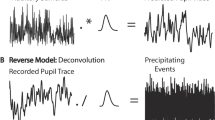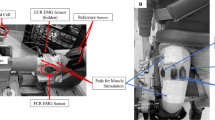Abstract
Power-spectral analysis was used to measure the bandwidth of the frequency of movement at the human elbow joint. The maximum frequency of voluntary movement was found to be limited by muscle damping and limb inertia rather than by central processes and, for oscillation of the arm about the elbow, was 4–6 Hz. The maximum frequency at which a subject could move his elbow coherently with a kinaesthetic stimulus was found to be 2 Hz, so that movements with a frequency between 2–6 Hz must be open-loop in nature and there-fore must be learned or preprogrammed.
Sommaire
On a mesuré les transmissions caractéristiques des chemins des réflexes toniques d'étirement chez l'homme intact en appliquant, au coude, des couples de tortion perturbateurs et en enregistrant les réponses de l'électromyogramme intégré (e.m.g.i.) du biceps brachii. L'analyse corrélative croisée a permis d'extraire de l'activité e.m.g. totale, des variations de l'e.m.g.i. qui étaient correlées avec les changements d'angle du coude. On a trouvé que les réponses de l'e.m.g.i./réflex sont sans distortion harmonique et sont donc apparentées linéairement avec le signal faible des mouvements d'étirements sinusoïdaux. Il a été remarqué que les caractéristiques de tranfert sont plus compliquées que celles décrites pour des chats anesthésiés ou décérébrés. Les courbes de réponse de fréquence contiennent un nombre de sommets de résonance, et le déphasage en avant va de 100° à 180° alors que la fréquence d'étirement sinusoïdal augmente vers 5 Hz.
Zusammenfassung
Durchlaßcharakteristiken der Tonisch-Strecken Reflexbahnen in dem Intakt-Mensch wurden durch die Anlegung störender Drehmomenten um die Ellbogen und die Registrierung des integrierten Elektromyogramms (i.E.M.G.) der Bizeps brachialis gemessen. Kreuz-Korrelation Analyse ermöglicht aus der ganzen E.M.G.-Tätigkeit die Gewinnung von i.E.M.G.-Schwankungen, die in Übereinstimmung mit Ellbogen-Winkel Änderungen gebracht wurden. Die i.E.M.G. Reflex-Reaktionen waren harmonisch störfrei und und standen daher im linearen Zusammenhang mit den kleinsignalen, sinusförmigen Sehnenbewegungen. Man beobachtete Übertragungseigenschaften, die komplizierter waren, als diejenige, bei narkotisierten oder enthirnten Katzen. Die Frequenzkurven enthielten mehrere Resonanzspitzen und die Phasenvoreilung rückte von 100° zu 180° vor mit zunehmender Frequenz der sinusförmigen Strecken gegen 5 Hz.
Similar content being viewed by others
References
Bekey, G. A. (1962) The human operator as a sampled-data system.IRE Trans. Human Factors Electron. 3, 43–51.
Blackman, R. B. andTukey, J. W. (1958)The Measurement of Power Spectra. Dover Publications, New York.
Craik, K. J. W. (1947) Theory of the human operator in control systems. 1. The operator as an engineering system.Brit. J. Psychol. 38, 56–61.
Davis, R. (1957) The human operator as a single-channel information system.Quart. J. Exp. Psychol. 9, 119–129.
Ellson, D. G. andGray, F. (1948) Frequency response of human operator following a sine wave input. USAF AMC Memo Rep. No. MCREXD-694-2N.
Ellson, D. G. andWheeler, L. Jr. (1951) Resonance in the human operator. USAF WADC Tech. Rep. No. 5834.
Gibbs, C. B. (1954) The continuous regulation of skilled responses by kinaesthetic feedback.Brit. J. Psychol. 45, 24–39.
Gottsdanker, R. M. (1956) The ability of human operators to detect acceleration of target motion.Psychol. Bull. 53, 477–487.
Hick, W. E. (1948) Discontinuous functioning of the human operator in pursuit tasks.Quart. J. Exp. Psychol. 1, 36–51.
Jenkins, G. M. andWatts, D. G. (1968)Spectral Analysis and its Applications. Holden-Day, San Francisco.
Navas, F. (1963)Sampling or Quantization in the Human Tracking System. Masters thesis, Department of Electrical Engineering, Massachusetts Institute of Technology, Cambridge, Mass.
Navas, F. andStark, L. (1968) Sampling or intermittency in hand control system dynamics.Biophys. J. 8, 252–302.
Noble, M., Fitts, P. M. andWarren, C. E. (1955) The frequency response of skilled subjects in a pursuit tracking task.J. Exp. Psychol. 49, 249–256.
Partridge, L. D. (1965) Modification of neural out-put signals by muscles: A frequency response study.J. Appl. Physiol. 20, 150–156.
Partridge, L. D. (1966) Signal handling characteristics of load moving skeletal muscle.Amer. J. Physiol. 20, 1178–1191.
Poulton, E. C. (1957) On prediction in skilled movements.Psychol. Bull. 54, 467–478.
Sheridan, T. B. (1960) Experimental analysis of time-variation of the human operator's transfer function.Internal. Fed. Autom. Control 2, 629–635.
Stark, L. (1968)Neurological Control Systems. Studies in Bioengineering. Plenum Press, New York.
Stark, L., Iida, M. andWillis, P. A. (1961) Dynamic characteristics of the motor co-ordtinaion system ni man.Biophys. J. 1, 279–300.
Stark, L., Okabe, Y. andWillis, P. A. (1962) Sampled data properties of the human motor co-ordination system. Quarterly Progress Report No. 67, Research Laboratory of Electronics, Massachusetts Institute of Technology, 220–223.
Telford, C. W. (1931) Refractory phase of voluntary and associative responses.J. Exp. Psychol. 14, 1–35.
Vince, M. A. (1949) Rapid response sequences and the psychological refractory period.Brit. J. Psychol. 40, 23–40.
Welford, A. T. (1952) The ‘psychological refractory period’ and the timing of high-speed performance—a review and a theory.Brit. J. Psychol. 43, 2–19.
Young, L. R. (1962) A sampled data model for eye tracking movements. Sc.D. Thesis, Department of Aeronautics & Astronautics, Massachusetts Institute of Technology, Cambridge, Mass.
Author information
Authors and Affiliations
Rights and permissions
About this article
Cite this article
Neilson, P.D. Speed of response or bandwidth of voluntary system controlling elbow position in intact man. Med. & biol. Engng. 10, 450–459 (1972). https://doi.org/10.1007/BF02474193
Received:
Revised:
Issue Date:
DOI: https://doi.org/10.1007/BF02474193




